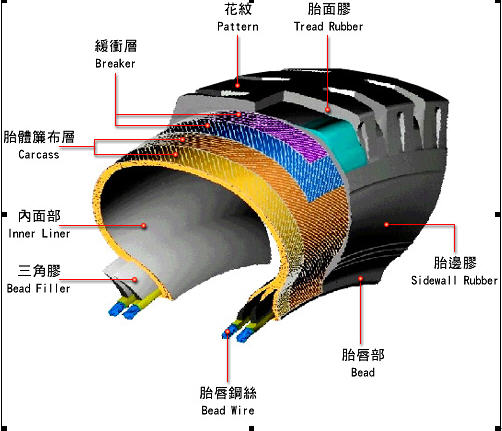
TIRE CARE AND MAINTENANCE
1Tire selection
Do not mount tires wider or narrower than the original-equip-
ment tires, either of which could negatively affect the motorcycle’s handling.
The choice of a tire that does not strictly conform to the original equipment specifications for a particular bike must be validated by a professional technician.
Never use a tire that is not inflated to the correct pressure, in excess of its indicated speed rating, or with a load that exceeds its load index.
2Inspection
Tires must be inspected on a routine basis for irregular wear pat-
terns, which can be an indication of incorrect inflation pressure, overloading or mechanical problems. An underinflated or overloaded tire that is ridden for a prolonged period may suffer irreversible damage that can have serious consequences, even if the tire is returned to correct inflation pressure.
Tires should be inspected regularly, with particular attention paid to:
• the tread area, to detect the presence of debris, cuts,deterioration or irregular wear patterns;
• sidewalls, to detect impact damage (from potholes or curbs), cuts, cracking or abnormal deformation;
• the bead area, noting any trace of abrasions or rim damage. If you suspect any problems, your tires should be inspected internally and externally by a professional technician.
3Wear
Do not allow the tires to wear smooth before replacing them. MICHELIN® motorcycle tires have wear indicators; smooth sections appear in the tread grooves, across the tread, when the remaining tread depth is 1/32 inch (.8mm).
Tread wear indicators identify when the tire needs replacing. Note: The federal regulation is 1/32 inch. However, some states have a 2/32-inch requirement for motorcycle tires. Check the condition of the tires regularly and replace them when necessary. A tire’s tread life is dependent on several factors, such as inflation pressure, loads carried, vehicle speed, braking and acceleration tech-nique, type of road surface, and ambient temperature. Mechanical problems can also cause premature wear, including warped rims, worn suspension components, loose steering-head bearings and/or frame misalignment.
4Inflation
Correct inflation is essential to the tires’ performance, comfort and durability. Riding underinflated tires can lead to premature wear, irrevers-ible damage to the carcass, and possible tire failure. Tire pressure should be checked every two weeks. Check pressure only when tires are cold, because pressure increases with temperature. Never bleed air from a hot tire.
Michelin recommends the tire pressure quoted by the motorcycle manufac-turer, except where otherwise stated. Michelin recommends the use of valve caps at all times. Caps help prevent air loss and keep dirt out of the valve mechanism.
5Mounting/Balancing/Demounting
The mounting and demounting of tires should be undertaken only by a professional technician; improper handling of the tire may cause irreparable damage that renders the tire unusable.
When replacing a tire, the installer must confirm the following:
• that the replacement tire is the correct size, as specified by the motorcycle manufacturer;
• that the speed rating and load index of the replacement tire are correct for the motorcycle;
• for certain motorcycles, the manufacturer specifies a particular brand and model of tire. Always refer to the owners manual or the tire manufacturer’s fitment guide for confirmation, or consult with a dealer that sells the brand of motorcycle in question.
The valve stem should be replaced whenever a tire is installed, as the valve is essential to ensuring that the tire is airtight. It is illegal to ride on a public highway with slick tires or any other tires that are marked NHS (Not for High-way Service) or “FOR COMPETITION USE.”
6Repairs
Michelin does not condone or endorse the repair of any of its motor-
cycle tires that have suffered punctures or other damage. Michelin assumes no
liability for injuries or consequential damages arising from Michelin® motor-
cycle tires that have been patched, plugged, sealed or otherwise repaired by
a dealer, distributor or consumer.
7Break-in
Avoid rapid acceleration or hard cornering for the first 50 miles
after mounting new tires. Increase lean angle progressively until the tire’s mold release compound is completely worn off the tread area.
8Warm-up period
At the start of each ride, travel a few miles at moderate speed. This will gradually bring the tires up to their normal operating tem perature. Once fully warmed up, the tires will achieve optimal grip.
9Mixing of tires
All recommendations and advice contained herein are based on the use of Michelin motorcycle tires on both the front and rear of the motorcycle. Unless otherwise recommended by Michelin, we strongly discourage mixing radial and bias-ply tires on individual motorcycles.
10HOW TO READ A TIRE SIDE WALL?
Rear Direction of rotation for rear tire, indicated by an arrow on the tire sidewall
180 Maximum external width of the tire, expressed in millimeters
55 Aspect ratio, the cross-sectional height divided by the tire width
R Radial construction
17 Bead-seat diameter of the wheel, expressed in inches (1 inch = 2.54 cm)
M/C Tire for motorcycles or scooters
73 Load index, i.e., 73 corresponds to a load of 805 pounds (365 kg) per tire
W Speed rating, i.e. (W) corresponds to a speed in excess of 168 mph (270 km/h)
Pilot Road 2 The tire’s model name
Michelin Tire manufacturer
Made in Spain Country of manufacture
Tubeless No tube is used, when mounted on a tubeless rim; abbreviated ‘TL’
Tube-Type Tire or wheel requiring an inner tube; abbreviated ‘TT’
